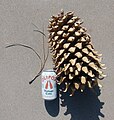Coulter pine
| Coulter pine Pinus coulteri | |
|---|---|

| |
| A Pinus coulteri seed cone at Mount Wilson, California | |
| Scientific classification | |
| Kingdom: | Plantae |
| Clade: | Tracheophytes |
| Clade: | Gymnospermae |
| Division: | Pinophyta |
| Class: | Pinopsida |
| Order: | Pinales |
| Family: | Pinaceae |
| Genus: | Pinus |
| Subgenus: | P. subg. Pinus |
| Section: | P. sect. Trifoliae |
| Subsection: | P. subsect. Ponderosae |
| Species: | P. coulteri
|
| Binomial name | |
| Pinus coulteri | |

| |
| Natural range | |
Coulter pine (Pinus coulteri), or big-cone pine, is a native of the coastal mountains of Southern California in the United States and northern Baja California in Mexico. Isolated groves are found as far north as Clearlake, California on the flanks of Mt. Konocti and Black Diamond Mines Regional Preserve. It is named after Thomas Coulter, an Irish botanist and physician. The Coulter pine produces some of the heaviest cones of any pine tree, up to 5 kg (11 lb) and among conifers is exceeded only by the cones of Araucaria bidwillii.
Although it has a limited range in the wild, the Coulter pine is a popular ornamental tree and is grown in many countries.
Description
[edit]Pinus coulteri is a substantial coniferous evergreen tree in the genus Pinus. The size ranges from 10–24 m (33–79 ft) tall,[2] and a trunk diameter up to 1 m (3.3 ft). The trunk is vertical and branches horizontal to upcurved. The leaves are needle-like, in bundles of three, glaucous gray-green, 15–30 cm (5.9–11.8 in) long and stout, 2 mm (0.079 in) thick.
The outstanding characteristic of this tree is the large, spiny cones which are 20–40 cm (7.9–15.7 in) long (occasionally as much as twenty inches (51 centimeters) length has been observed),[3] 23 centimeters (nine inches) in width,[4] and weigh 2–5 kg (4.4–11.0 lb) when fresh. Each segment, or "scale", of the cone is tipped with a talon-like hook. Coulter pines produce the largest cones of any pine tree species and people are advised to wear hardhats when working in Coulter pine groves, although the slender cones of the sugar pine are longer. The large size of the cones, combined with the claw-like scales, has earned them the nickname "widowmakers" among locals.
Ecology
[edit]The Coulter pine is closely related to the foothill pine, Pinus sabiniana. It is more distantly related to Jeffrey pine with which it shares habitats, and the ponderosa pine.[5] Coulter pines tend to grow in drier environments than ponderosa and Jeffery pines.
This erect, medium-sized pine prefers south-facing slopes between 200–2,300 m (660–7,550 ft) elevation, and tolerates dry rocky soil. Pinus coulteri most often appears in mixed forests. The Coulter pine occurs in a number of forest plant associations; for example, at higher elevations forestation of the San Jacinto Mountains Coulter Pine is co-dominant with the California black oak.[6] Woodpeckers often forage on the species, and peel the bark to access insects underneath.[7]
Uses
[edit]Wildlife, especially squirrels, gather the large seeds. They were also once eaten by Native Americans.[8]
The wood is weak and soft, so that the species is little used other than for firewood.
Pinus coulteri is cultivated as an ornamental tree, planted in parks and large gardens, and drought tolerant landscaping. The Coulter pine has gained the Royal Horticultural Society's Award of Garden Merit.[9]
Gallery
[edit]-
Pollen cones (male cones)
-
Mature tree, as seen from under branches at ground level
-
Close-up of bark detail
-
Foliage and cones
-
Cones on ground in their natural setting
-
Large cone, found at 4,150 ft elevation in the Santa Lucia Ranger District of the Los Padres National Forest, California Coastal Range of the Central Coast.
-
Exceptional cone example, shown with needle cluster (soda can for scale).
-
Cone
-
Close-up of spiral detail
-
Close-up of barb detail
-
Seeds
-
A view of the upper portion of a mature Coulter Pine.
References
[edit]- ^ Farjon 2013.
- ^ Earle 2018.
- ^ Lanner, Ronald M. (1999). Conifers of California. Los Olivos, California: Cachuma Press. pp. 73–74.
- ^ Gardener's Chronicle Volume 23 (third series)(March 28, 1885) Page 415
- ^ Cope 1993.
- ^ Hogan 2008.
- ^ NWF Field Guide.
- ^ Whitney, Stephen (1985). Western Forests (The Audubon Society Nature Guides). New York: Knopf. p. 410. ISBN 0-394-73127-1.
- ^ RHS Gardening.
Bibliography
[edit]- Chase, J. Smeaton (1911). "Pinus Coulteri (Coulter-pine, Big-cone-pine, Pitch-pine, Bull-pine)". Cone-bearing Trees of the California Mountains. Eytel, Carl (illustrations). Chicago: A.C. McClurg & Co. pp. 24–26. LCCN 11004975. OCLC 3477527.
- Cope, Amy B. (1993). "Pinus coulteri". Fire Effects Information System (FEIS). US Department of Agriculture (USDA), Forest Service (USFS), Rocky Mountain Research Station, Fire Sciences Laboratory.
- Earle, Christopher J., ed. (2018). "Pinus coulteri". The Gymnosperm Database.
- Farjon, A. (2013). "Pinus coulteri". IUCN Red List of Threatened Species. 2013: e.T42352A2974687. doi:10.2305/IUCN.UK.2013-1.RLTS.T42352A2974687.en.
- Kral, Robert (1993). "Pinus coulteri". In Flora of North America Editorial Committee (ed.). Flora of North America North of Mexico (FNA). Vol. 2. New York and Oxford: Oxford University Press – via eFloras.org, Missouri Botanical Garden, St. Louis, MO & Harvard University Herbaria, Cambridge, MA.
- Hogan, C. Michael (2008). Stromberg, Nicklas (ed.). "Pinus coulteri". Globaltwitcher.com. Archived from the original on 2012-02-18.
- Moore, Gerry; Kershner, Bruce; Tufts, Craig; Mathews, Daniel; Nelson, Gil; Spellenberg, Richard; Thieret, John W.; Purinton, Terry; Block, Andrew (2008). National Wildlife Federation Field Guide to Trees of North America. New York: Sterling. p. 86. ISBN 978-1-4027-3875-3.
- "Pinus coulteri". RHS Gardening. Royal Horticultural Society. Retrieved 2013-09-27.[permanent dead link]
External links
[edit](Coulter pine).
Text is available under the CC BY-SA 4.0 license; additional terms may apply.
Images, videos and audio are available under their respective licenses.














